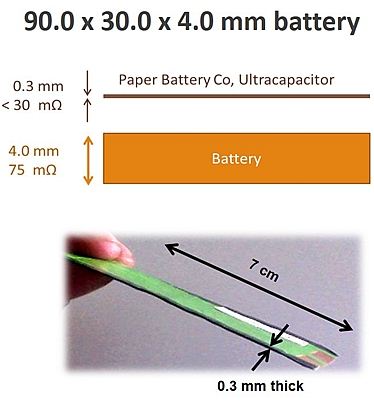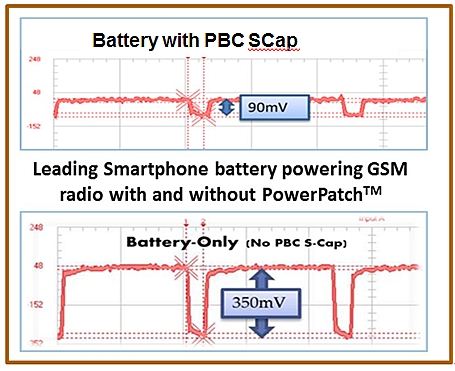When I first heard about paper batteries, I was skeptical. I have worked in a battery company that uses polyester film and similar materials, but it is actually paper?
I am very curious about this, so I especially want to talk to Shreefal Mehta, CEO of Paper Battery Corporation (PBC), and Dave Rich, Senior Director.
PBC was founded in 2008 and is located in the north of New York State. The company's vision is roll-to-roll printing to produce scalable, flexible, and structured energy storage materials. This technology enables the manufacture of batteries and supercapacitor (energy and power) materials on the same high volume printing line.
PBC is now developing ultra-thin supercapacitor technology that is said to enhance the battery performance of mobile devices and other products that rely on traditional rechargeable lithium batteries. The technology is a unique, relatively non-incorporated (only 0.3mm thick) technology that works with existing battery solutions and is environmentally friendly. With this scalable technology, energy storage and distribution can be significantly improved, and cost-effective and space-efficient sheet products can be easily designed into a variety of electronic products.
PCB companies are looking for embedded devices that are getting smaller, thinner and battery-powered, so they are determined to develop thin, cheap designs for batteries. I want to know how good this technology is.
PBC also announced a partnership with leading battery manufacturer TWS, one of the top five battery suppliers in the world.
In order to understand this technology in more depth, I asked some questions and did some research.
Who doubts everything
I have found that the new University of Lisbon in Portugal has done a lot of research and development on paper thin film batteries built on cellulose paper. This cellulose paper is also used as an electrolyte at the same time, which functions as a separate electrode and as a physical support for a rechargeable battery. As a matter of fact, the 3V prototype battery has been able to control the on/off state of the paper transistor.
In 2013, Purdue University successfully produced lithium-ion batteries using flexible paper-based current collectors. The current collector is fabricated on ultrafine wood fibers covered with carbon nanotubes, and an electrostatic laminate nano-assembly process 2 is employed.
So no problem - it can be done. Now I am interested in the design of the paper battery company.
Paper battery company's craft
Paper Battery Corporation's (PBC) PowerPatch product line includes ultra-thin, pattern-addable supercapacitors with interconnects and packages designed to form compact energy modules with operating voltages ranging from 2V to 7.8V, depending on Target life.
This first-generation product implements a limited subset of the PowerWrapper technology platform, highlighting PBC's packaging innovations for this next-generation ultra-thin, pattern-addable supercapacitor.

Typical conventional battery sizes are 90x30x4mm, equivalent series resistance (ESR) is 75mΩ; paper battery company's solution size is 7cmx4mmx0.3mm, ESR is less than 30mΩ.
Even more gratifying is that this design is very environmentally friendly: the electrodes used in supercapacitor technology are composed of high surface area activated carbon, carbon nanotubes or graphene. Paper or other porous polymer separators contain the electrolyte and separate the electrodes. The collector is usually an aluminum foil that is connected to the electrodes and carries the input and output of the charge. PowerPatch products do not have the toxic heavy metals commonly found in batteries and are fully RoHS compliant.
Reduce pressure drop
The second generation of PowerPatch products significantly reduces pressure drop in a truly small space.

The top graphic is a traditional battery with PBC's supercapacitor. The bottom graph shows a significant voltage drop in conventional GSM handheld radios with conventional batteries.
Paper can adapt to complex shapes

Traditional batteries are difficult to assemble into complex shapes. A thinner battery means a lighter, thinner exterior product design.
New product design examples. The battery/supercapacitor can now be placed around the PCB to meet the minimum volume requirements of the product. It is now also easy to make distributed capacitors. This design reduces voltage variations on the PCB, reduces many PCB components, and provides peak power pulses to one or more loads simultaneously. The flexibility of the choice of form factor allows for irregular shapes while still providing excellent thermal and RFI (radio frequency interference) benefits.
Implied advantage
The slim shape makes PowerPatch very useful for spreading and shielding heat. PowerPatch's architecture is designed to make electromagnetic interference "quiet" and can be used as a shield for RFI.
This technically supported application:
Capacitive touch screen - noise (electromagnetic interference) is the primary problem of capacitive touch screens. PowerPatch can not only be used as a shield, but also help maintain the voltage stability of the LED driver.
Camera Flash - Most mobile phone cameras over 1.3 megapixels require a powerful photo flash and an ultra-bright flashlight for easy photography in low light conditions. Flash intensity directly and indirectly affects image quality3. The power pulses supplied to the flash require high energy and very low ESR.
Smart Watches - Although smart watches are new, they are still limited in functionality as a stand-alone device for smartphones or tablets. The evolution of functionality requires better power to extend communication distances and increase data rates.
Battery-powered small bass and subwoofer sound systems - For the best sound, the supply voltage must be as small as possible to accommodate transient power requirements, especially when only current demand changes. Supercapacitors with high energy density and low ESR can improve system performance in this situation. The thinner the dimensions allow them to fit into the industrial design of the final product or bass generation subsystem.
Personal audio amplifiers and medical hearing systems - integrated with Bluetooth and other wireless RF technologies, data streams can be accessed directly into the device. RFI and Real Hearing Assistance Center (THAC) issues.
LED Drivers - Voltage stability, increased efficiency, thermal and RFI benefits, and cost and size advantages.
future
Future growth will be driven by expanding products to large-scale performance stacks and packaging energy into structured units such as solar array backplanes to hybrid vehicle battery packs.
PowerPatch implementations can have multiple outputs, and there will be multiple voltages in the future. These advantages enable PowerPatch to connect to multiple adjacent loads in order to achieve the lowest possible ESR. PowerPatch can be used to multiply and divide voltages and then feed them directly to the load, either as an input to a voltage converter or as a memory for a voltage converter.
In the future, PowerPatch will support the direct installation of components to PowerPatch, such as voltage regulator components, switches and control devices, and RFID components.
Dog Training Receiver,Waterproof Dog Shock Collar,Rechargeable Remote Dog Trainer,Small Dog Shock Collar With Remote
Elite-tek Electronics Ltd , https://www.aetertek.ca